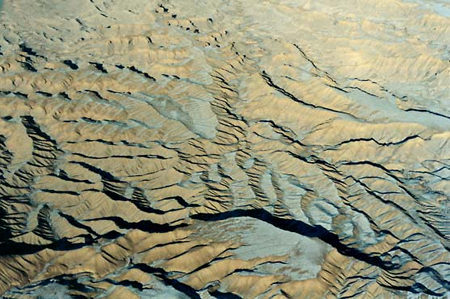

September, 1959, Owl Draw
It had already been a long day for Bert Davidson and yet was barely noon. Bert had been working since well before dawn in what he'd dubbed the Last Chance Mine, hand-mucking a pocket of uranium ore.
Hand mucking was hard business, and Bert looked forward to taking this load into the mill at Moab, where he could get a hot meal before returning. Doing a visual check of his tires, he swung up into the cab of the old Chevy truck that he'd bought from a potato farmer over in Colorado.
Sitting a bit cockeyed to see around the bullet holes in the windshield, Bert headed up the wash, bouncing and wallowing on the wide bench seat---he could tell he'd overloaded the truck a bit, but it wasn't the first time. The more ore he could haul, the better.
Climbing up the steep grade out of the wash, Bert geared down and inched his way over a huge slickrock shelf that always gave him trouble. Sometimes he'd have to back down and try it a couple of times before inching up and over, the heavy load always complicating things.
This time, he'd easily cleared the bench with his front wheels, but when he inched the back ones slowly over, he felt an unexpected bounce from the weight and at the same time heard the sharp crack of metal breaking. He cussed and stopped, then got out. Bad news---he'd broken his rear axle.
It was a long walk out, at least 10 miles to the nearest road where he might, if he was really lucky, get a ride with someone to the main highway, another 30 or so miles away. It was too damn hot to walk out anyway, and there was no way he could carry enough water to get him much of anywhere. Maybe if he waited till dark when it cooled off he'd stand a chance, but chances were equally good he'd die out here.
Bert sat on his heels in the shade under a juniper tree and pondered his fate when he thought he heard a faint buzzing. At first he gave it no mind, thinking it was a bee, but when it became more of a distant drone he jumped up and looked to the sky. It was an airplane, a very rare sight out here in the canyons.
Bert was in luck, for the plane would pass directly over him. He took off his shirt and waved it. The plane turned and passed over him again, then again, while he waved and jumped up and down. The plane finally waggled its wings, then flew on. Four hours later, a fellow in a pickup showed up and took Bert to Moab, where he bought a new axle.
The plane was piloted by the legendary canyon flyer Dick Smith, who knew the canyons like the back of his hand and later met his end flying them. That new axle bought Bert a few more months in the mining business, but Last Chance was aptly named, and Bert soon left the country and went to Alaska. He often wondered what would have become of him without that airplane flying over when it did.
September, 1999, White Rim
Forty years later, I'm crawling up the road with my friend Arnie, me on my old Miyata mountain bike and he on a newer Giant. We just spent the night in Lathrop Canyon, maybe 60 miles as the crow flies from my uncle Bert's Last Chance Mine. It's hot, and we're doing more pushing than riding. Stunning huge chunks of sandy White Rim sandstone lie askew where they tumbled long ago onto the lower layers of ruby-red Cutler below.
It's our last day on the White Rim, and as usual, our support vehicle and fellow riders are miles behind---probably still asleep. When our friend Michelle invited us to go along with her friends, I had no idea that their idea of riding the White Rim was to ride IN the truck, bicycles piled in back.
We're finally back on the White Rim and drop our bikes on the ground to catch our breath. We can see a group of bikers coming up the canyon below us---we camped near them last night. A small white plane circles high above as if looking for something. It must've seen us, for now it turns and heads our way, losing altitude until it's buzzing overhead.
Arnie hates airplanes. He gives a one-finger salute, and the plane circles back.
"What the heck, Arnie, you're egging them on," I say. "I want a tail number," Arnie answers, "It's illegal to buzz people." He drops his pants as the plane swoops over again, mooning them.
"Did you get the tail number?" he asks.
"No, but they're coming back. You get it."
The plane comes back again, this time even lower, and Arnie dramatically hits the ground just as they pass over. I see something falling away from the plane, a small brown package. It tumbles through the air and lands nearby.
"Bastards!" Arnie yells, shaking his fist. "Now they're bombing us. Get their tail number!"
The plane comes back one last time, waggles its wings, then gains altitude and is quickly gone. Arnie now has the package, ripping it open.
"Well I'll be gotohell," he whispers with awe.
"Hagen-Daze ice-cream bars. A bunch of 'em, too."
In the backcountry, possession isn't 9/10ths of the law, it's 10/10ths, and Arnie and I are soon enjoying ice cream, a most unlikely proposition considering where we are. But it isn't long until the Moab mountain bikers arrive. Arnie informs them, "It's illegal to make airdrops in national parks. Good thing we got the tail number."
The bikers look glum, saying nothing. I suspect the ice cream was meant for them.
Arnie then adds, "But I have trouble remembering numbers. You might as well have some ice cream, cause we sure as hell can't eat it all."
Smiles all around.
This particular air drop is luckier than one that dropped ice cream to rafters in Cataract Canyon a few years back. That plane caught a wingtip in the river and crashed.
A call later to Canyonlands National Park confirms what Arnie says---it is illegal to drop anything from an airplane over national park lands, as well as to buzz people. A quick call to the FAA with a tail number can result in a fine for the pilot. The same applies if an airplane creates a nuisance of itself,which can be interpreted according to circumstances, e.g., hikers can report planes that circle over them, even at high altitudes (although obtaining a tail number may be difficult). The FAA recommends that pilots fly at least 2,000 feet above areas where people are present (including in national parks and wilderness areas). It's also illegal to land a plane in a wilderness area or wilderness study area (WSA), except in an emergency.
Yet deep in the heart of some of the most spectacular country in the San Rafael Swell (or the entire world, for that matter) lies the Mexican Mountain airstrip at a latitude of 39 01.142 N and a longitude of 110 27.030 W, elevation 4660 feet, with a runway length of 1325 feet and a width of 40 feet. It has a windsock, runway orientation of 11-29, and a surface of packed dirt with pebbles. That's about all you need to land a plane there (as long as you have a plane and pilot's license).
The Mexican Mountain strip sits right smack in a wilderness study area. The Utah Back Country Pilots' description for Mexican Mountain reads, in part: "This is in a beautiful spot with indian pictographs near the runway to the NE and many beautiful hikes in the area. Unfortunately the environmentalists think so too and don't want airplanes here. In the spring of 2001 someone drug logs onto the runway. They have since been removed but check carefully for human created obstacles before committing to land."
One might add that you should also check carefully for firepits in the runway left by campers, as well as for airplane-shy pack llamas nearby, additional hazards that have been encountered during the 100 landings (BLM rough estimate) that are made here each year. Once out of their planes, pilots are on their own like any hiker. (And note that if their planes for some reason refuse to start up, they're usually in more trouble than the average hiker, who planned on hiking out anyway.)
Mexican Mountain is one of the few remote airstrips in southeast Utah in a WSA, and the BLM has posted a sign at the airstrip cautioning hikers to not camp on the strip (though they do anyway) and explaining that the strip is legal (pre-dating the WSA and also being partially on state lands). Of course, pre-existing roads in the WSA are NOT open to off-road vehicles of any kind, but airplanes are not considered off-road vehicles by the government.
The Mexican Mountain airstrip is one of a dwindling number of remote strips still in use and actively maintained (by pilots), for many of the old strips (originally built primarily for mining access in the 1950s and 60s) are overgrown with brush.
Backcountry airports are important to those who want to camp in remote places, using their planes as a base. Many fear the permanent closure of remote airstrips by environmentalists (usually defined as anyone who doesn't want such airstrips to remain, even if it happens to be an outfitter who wants the backcountry all for him/herself and his paying clients).
In 1998, a group of aviators formed the Utah Back Country Pilots (UBCP), drafting a mission statement that reads, in part, "To preserve Utah's backcountry landing strips through public involvement in land use issues and volunteering time and resources toward air strip maintenance. And a pledge to protect the environment by promoting "leave no trace" camping."
According to the Price BLM office, the Mexican Mountain strip is a prime example of the leave-no-trace ethic, as periodic checks find virtually no trash and only matted vegetation where tents sat.
In 1999, the first federal protection of a Utah backcountry landing strip was granted when the BLM authorized a Title Five right-of-way at the Mineral Canyon landing strip a few miles north of Canyonlands National Park on the Green River. This right-of-way allows the strip to be maintained and also allows its location to be depicted on aviation charts. The designation was considered a notable forerunner by the UBCP.
Karl Spielman of the UBCP writes: "Some may argue that airplanes do not fit the character of the backcountry. This is simply uninformed or selfish on their part. The airplane uses only a small strip of land, typically about the width of a dirt road and less than one-quarter mile in length. An airplane has no drive train connected to its wheels and by its very nature renders one on foot after landing! Only footprints leave the airstrip." (http://www.sharetrails.org)
The main problem with airplanes, it appears, is the noise and visual impact, and although the effects of military overflights have been studied (suchoverflights can radically disturb nesting or migrating birds, as well as mammals such as bighorn sheep and antelope), the effects of light planes flying over the backcountry are less known---on animals, at least, for backcountry hikers seem to like them only in emergency rescues.
September, 2002, Hurrah Pass
A few years after our White Rim trip, Arnie and I are standing at the top of Hurrah Pass, out on the rim, watching a pair of ravens soaring and riding the thermals. Sure enough, the scene soon includes an airplane, probably sightseers, and the magic's gone.
Arnie mutters something about humans not being meant to drive machines you can't park by the road when they break down.
I reply, "Look at it this way, Arnie. At least airplanes are self-limiting. Like Dennis Willis with the BLM up in Price says, if back-road users had the same skill, money, and regulatory requirements imposed on them that airplane pilots do, there would be a lot fewer of them. And airplanes don't cause on-ground damage."
"They still make too damn much noise," Arnie replies. "And as for these remote airstrips, everyone's missing the point. I could care less if an airplane's sitting on some remote strip, it's the noise of the damn plane getting to and from that strip that violates the feeling of remote that I've worked hard to find, all on my own two legs. Park rangers have the same effect on me," he adds.
I think for awhile, then say, "I'm surprised anyone even wants to fly these days. Thanks to 9-11, the military can use deadly force with no warning if a pilot violates restricted airspace, and that includes temporary restrictions, such as when V.P. Dick Cheney's around on vacation. And they don't bother to advertise these temporary restrictions. Sort of takesthe fun out of flying."
Arnie scowls and we're both quiet for awhile. The plane trails away into the distance. Arnie points to an immense cliff and says, "There was a dog stranded on the cliffs way over there a few years back. Seems like it had chased a bighorn up a little debris field into the rocks, way above that highest cliffline over there, a good 800 feet up. It couldn't get back down. Its owners could hear it barking, but they couldn't see where it was."
"What happened?"
"They tried everything they could think of, then after five days of hearing the dog bark but unable to find it, they had a ultralight fly above the highest cliffs. They found it from above and rescued it. It was the only way they could've ever found it. "Arnie continues, "I thought that was really cool that they'd do that. I guess nothing's simple, is it? But don't get me wrong, I still hate planes."
We watch as the ravens return, playing again in the thermals, backlit against red cliffs, then we finally get into Arnie's old Scout, muffler rocking, and head on home.
Chinle Miller can be reached at: chinlemiller@yahoo.com








